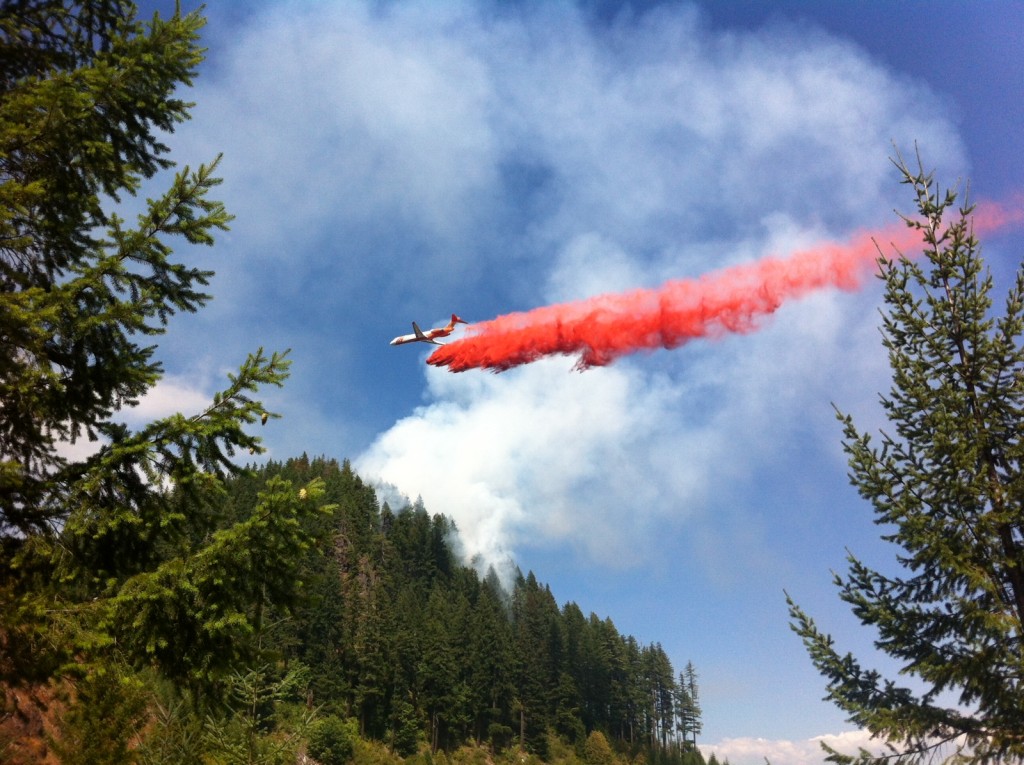The last few summers in Oregon have been hot and dry. In fact, for some parts of the state, 2015 was the third consecutive year of drought. In March, the National Weather Service announced that everything west of the Cascade Mountains is clear of drought for the first time since 2013. Those hot and dry conditions have resulted in staggering statistics for the past four fire seasons: wildfires have burned over three million acres in Oregon since 2012. Those are devastating numbers – wildfires threaten lives, destroy homes and damage forests and wildlife habitat.
A worsening “new normal” for fire season begs the question of whether climate change is contributing to an increase in wildfires and how wildfires contribute to greenhouse gas emissions. Both of those questions are extremely difficult for scientists to answer, but we do know that wildfires emit significant amounts of carbon dioxide. As trees grow, they absorb carbon dioxide out of the atmosphere, releasing the oxygen while locking the carbon away in the body of the tree – about half of a tree’s weight is stored carbon. Wildfires release that stored carbon through combustion.
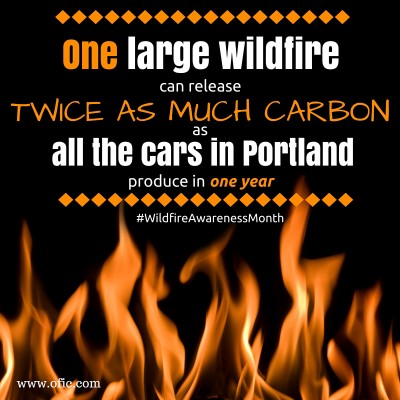 The amount released varies considerably from year to year and fire to fire depending on geography, tree species, and myriad other factors. One study found that one large Oregon wildfire released twice as much carbon as all the cars in the Portland metro region produce in a year. It’s estimated that the recent Fort McMurray fire in Canada– which has to-date burned about one-third the acreage burned in Oregon in the last four years — has emitted between 35 and 85 million tons of carbon dioxide equivalents. That’s equivalent to emissions from 10 to 25 million homes’ energy use for one year.
The amount released varies considerably from year to year and fire to fire depending on geography, tree species, and myriad other factors. One study found that one large Oregon wildfire released twice as much carbon as all the cars in the Portland metro region produce in a year. It’s estimated that the recent Fort McMurray fire in Canada– which has to-date burned about one-third the acreage burned in Oregon in the last four years — has emitted between 35 and 85 million tons of carbon dioxide equivalents. That’s equivalent to emissions from 10 to 25 million homes’ energy use for one year.
Over their life-times, trees growing in sustainably managed forests absorb carbon while providing habitat for wildlife, recreational opportunities, clean drinking water, and, when harvested, shelter for humanity. Much of that carbon in then stored in long-lived forest products while remaining wood residuals can be utilized to generate renewable energy. When the forest is replanted, this virtuous cycle begins anew. That cycle doesn’t happen when trees go up in flames. While wildfires may serve an important ecological role, proper forest management can often mimic that role while also capturing maximum value from that carbon storage.
Wildfire season is quickly approaching and while this season isn’t expected to be as bad as previous years, Oregon and Washington have already seen some fire activity, and preparation is top-of-mind for landowners right now.
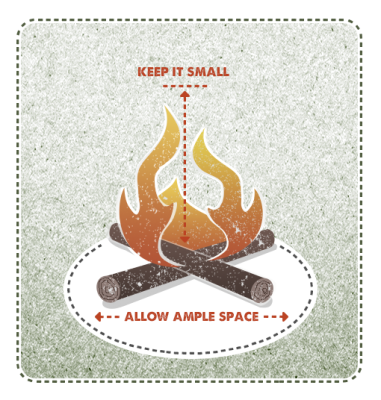
Image credit: Keep Oregon Green
May is Oregon Wildfire Awareness Month, and Keep Oregon Green, a 501(c)(3) non-profit corporation that has been educating the public on how to prevent wildfires for 75 years, estimates that people burned over 140,000 acres of state and federally protected lands in 2015. Throughout the month of May, Keep Oregon Green is reminding Oregonians to stop fires before they start by planning ahead, preparing for fire season, and preventing open fires and equipment from sparking a wildfire. “Simple prevention strategies will make the strongest impact on your home, family and community safety,” said Kristin Babbs, Keep Oregon Green president. Babbs recommends homeowners create “defensible space” around their homes by removing dead, flammable vegetation and limbing up trees. While weather-related wildfires (such as those started by lightening) are a major cause of natural wildfires, backyard debris burning is the leading human cause of wildfire issues in Oregon. Using common sense and following simple safety rules can prevent most debris burn-caused wildfires. Campfires are also a major cause of wildfires, in fact, 4000 acres of Oregon forest burned as a result of unattended campfires last year.
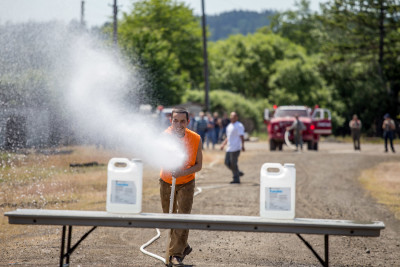
At a contractor fire training in Willamina, crews geared up for the coming fire season while competing to put out mock fires.
Wildfires started by workers and the equipment they operate in the forests and on farms pales in comparison to wildfires started at home and through recreation. In fact, less than a quarter of last year’s human-caused wildfires were started on the job. Many landowners host annual training events to help contract loggers and others get prepared for operating during fire season through equipment inspection, drills, and an overview of best practices. At a training event earlier this month, Allan Foutch, forest manager for Miami Corporation, addressed a crowd of loggers and trained fire-fighters. “This is where you live and the goal is to protect it and prevent fires in your own backyard,” Foutch said. “If there were a fire, you are the people we’d rely on to put it out. We don’t want to have to respond to a fire, but if we do, we need to know when to attack and when to retreat, and how to use our equipment quickly and efficiently so everyone is safe.”
In addition to reviewing fundamentals, the training offered an opportunity to talk about lessons from last year’s fire season. David Hampton, forester and owner of Hampton Affiliates, shared stories from the Willamina Creek Fire that occurred on Hampton, BLM and Hancock land last summer. Hampton noted that it’s not always as straight forward as, “putting the wet stuff on the red stuff” because logistics often get in the way. Access to the Willamina Creek fire was limited by a one-lane road and responders got bottlenecked trying to get fire trucks to the fire before proper traffic control was in place. Hampton also stressed taking time to get familiar with the landscape. “You have to assess what the fire is doing first,” Hampton said. “Safety is key. So are headlamps, though, you can’t see anything in the dark.”
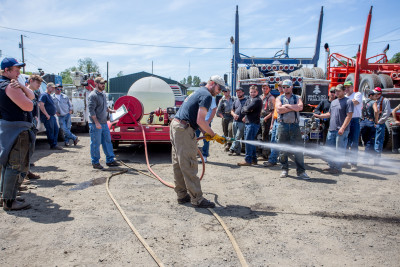
Oregon Department of Forestry tests for adequate water pressure on contractor fire trucks in anticipation of the coming fire season.
Oregon Department of Forestry was also on hand for courtesy fire truck inspections and to stress that recent years have seen earlier and more severe fire seasons. “I’ve been doing this for 22 years,” said Jason Rayburn, Wildland Fire Supervisor, “and it keeps getting worse and worse.” He said fire season used to start after Fourth of July and would start at low to moderate danger, and only get to high danger in August. Last year the fire season started off early in high danger, before the crews even came on board, and saw ten days of extreme danger. “That was off the charts and was a first in my career,” Rayburn said, “we have to up our game.”
The training wrapped up with hose and nozzle competitions, offering about $1,500 in cash prizes for winners who could quickly and properly operate their equipment under pressure. Foutch explained it was more than just a chance to shine, though. “It’s a real-time demonstration of what can go wrong if your hose isn’t rolled properly and your adrenaline is pumping.” All those who participated got a chance to re-roll their hoses under the watchful eye of experts so they’ll be prepared for the real deal.
“We’re here, and we’re ready to go,” said Hampton.
